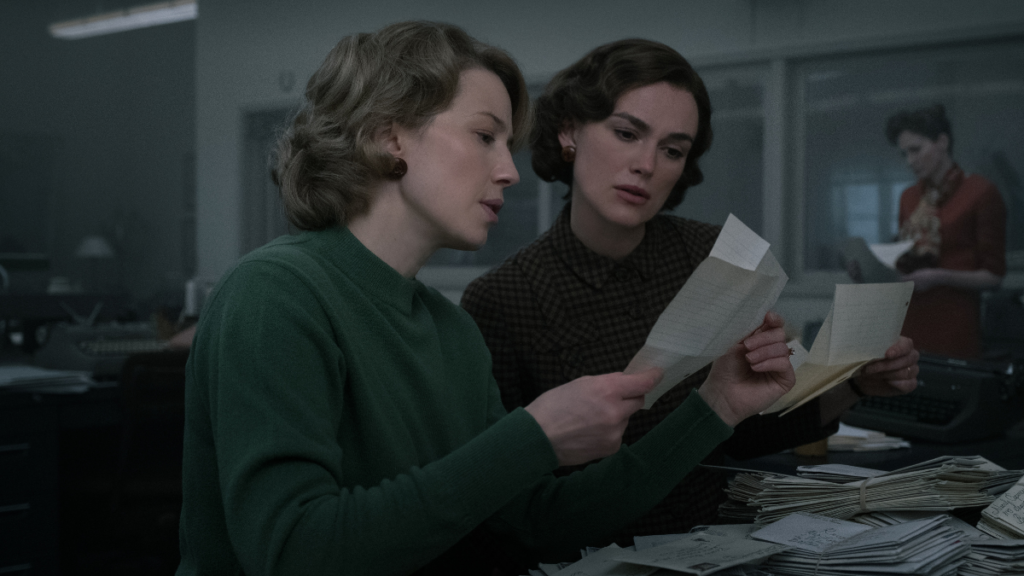‘Boston Strangler’ Review: Keira Knightley Shines as Journalist Advocating for Murdered Women

- Oops!Something went wrong.Please try again later.
- Oops!Something went wrong.Please try again later.
- Oops!Something went wrong.Please try again later.
To be a male serial killer of women one must be a misogynist. “Duh,” you’re probably saying, and yet we’re surrounded by sexy serial killer media, from Zac Efron as Ted Bundy to whatever Ryan Murphy is up to these days. It’s refreshing, then, that the historical crime drama “Boston Strangler” centers on a female journalist as she tracks that eponymous killer while avoiding glamorizing or sexualizing his actions.
Keira Knightley plays Loretta McLaughlin, a dogged journalist and mother of three who sees a way out of covering the lifestyle beat when she connects three similar murders. As she seeks justice for a growing tally of victims, her own womanhood is an inextricable part of the story.
The film begins in Ann Arbor, 1965, where a woman living alone is strangled to death. Her body is posed, nylon stockings tied around her neck in a sadistic, giftwrappy bow. We jump three years earlier, and 800 miles east, to Boston, where Loretta has been tasked with reviewing a new toaster. She begins to wonder if a series of local strangulations are connected and begs her editor (Chris Cooper, “American Beauty”) to let her work on it, pro bono.
Loretta’s hunch is right and she is suddenly launched into one of the biggest stories in the city. Jean Cole (Carrie Coon, “The Leftovers”), a veteran investigator, is tasked with making sure Loretta doesn’t screw things up. As Loretta follows the story with Jean at her side, she’s waylaid by the boys’ club culture of newsrooms and police stations, the inherent vulnerability of her sex, and her own husband (Morgan Spector, “The Gilded Age”).
Though not quite perfect, “Boston Strangler,” the latest from writer-director Matt Ruskin (“Crown Heights”), makes an admirable addition to its often exploitative genre. As the film says in an opening intertitle, this narrative is inspired by a true story. Loretta and Jean were real women, real reporters for the Boston Record-American (now the Boston Herald). By her own account, Loretta had to convince her editor to let her pursue the unconnected killings despite the assertion that these victims were “nobodies.”
But Ruskin does zhuzh things up to make “Boston Strangler” feel more urgent. The kills come fast and furious, with Loretta just a few steps behind the strangler — and, perhaps, the strangler just a few steps behind her. Film Loretta experiences sexism in her newsroom because she is one of several female journalists relegated to fluffy fare. In real life, Loretta said there was only ever one female reporter per shift. Rather than refer to her by name, colleagues called her “the girl.”
Still, the film compellingly captures the sexist energy of its era. Loretta’s sister-in-law calls her selfish for working instead of caring for her children and Loretta and Jean are routinely referred to as “skirts.” Ruskin pilfers one memorable slight from the actual events of 1962. “Two Girl Reporters Analyze Strangler,” a Record-American headline crows, attaching the kind of condescending awe to two thirty-something women doing investigative journalism that one might feel when watching a dog ride a skateboard.
The implicit details are even more exquisite. Swarms of male extras play cops and journalists, underscoring Loretta’s alienation. Ruskin works seriously and delicately to depict the strangler’s female victims. As women living alone in the 1960s they were especially vulnerable. Lingering shots of their homes, done up in excellent period detail by production designer John P. Goldsmith (“The OA”), persistently remind us that these women were people — people who bought milk, took baths, and hung family photos on their walls. Loretta also notices these things, and — as evidenced by Knightley’s impeccable performance — is deeply affected by the killings. In one goosebumps-inducing scene, she steels herself to look at crime scene photos for the first time.
Also Read:
Harvey Weinstein Sentenced to 16 Years in California Prison for Rape of Italian Model
The strangler’s attacks are depicted, though never gruesomely or exploitatively. Just one assault is shown briefly on-screen. The scene isn’t offensive, but it’s hard not to mourn the subtlety Ruskin and his cinematographer, Ben Kutchins (“The White Lotus”), lost in filming it. For the most part, they understand that it is both terrifying and empathetic to leave these atrocities to the imagination.
But if you’re looking for “She Said,” 1960s edition, this is not that film. Carrie Coon’s Jean is more in Loretta’s orbit than at her right hand and thus rendered somewhat flimsily. It’s unclear, for instance, why the editors trust her as an investigative reporter, but not Loretta. There is more competition than camaraderie between these women, and Coon is tragically underutilized as a result. The film charmingly showcases some of the sloggier bits of their reporting, though. If you thought Jodi and Megan had it rough trying to track down Gwyneth Paltrow, imagine having to call every Sullivan in the phone book — in Boston — with only some gumption and a rotary phone.
Though it drags in its third act, and mixes fiction into the actual Strangler case — thus arriving at some bizarre, scare-mongering conclusions — “Boston Strangler” is more deft than depthless. It’s a beautiful-looking film that is at its best when subdued, a quality Knightley embodies in her masterful lead performance.
“Boston Strangler” may muddle its facts, but its message never wavers. In a genre dominated by perfunctory intrigue, how exhilarating to see a film with morals this clear, consistent, and touching.
Also Read:
Disney CEO Bob Iger Is Open to Selling Hulu – But Finding a Buyer Will Be a Challenge | Analysis

